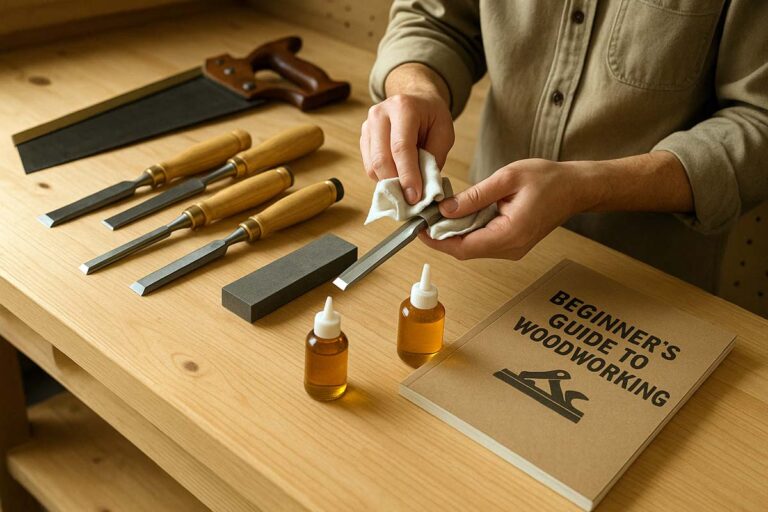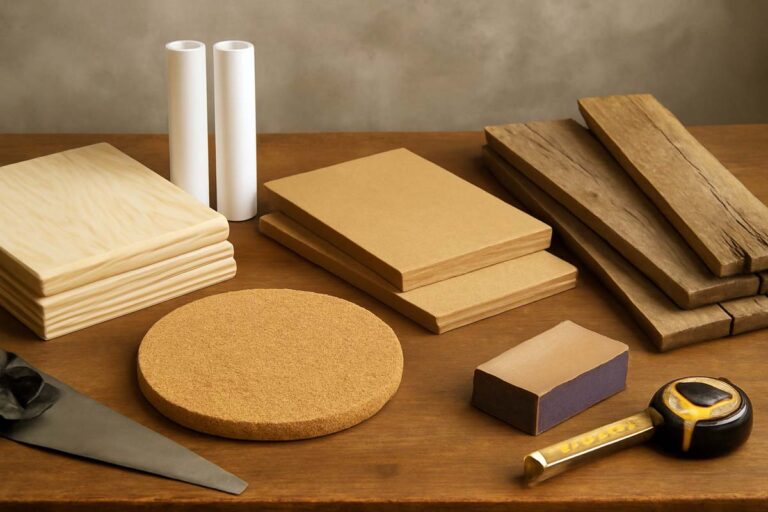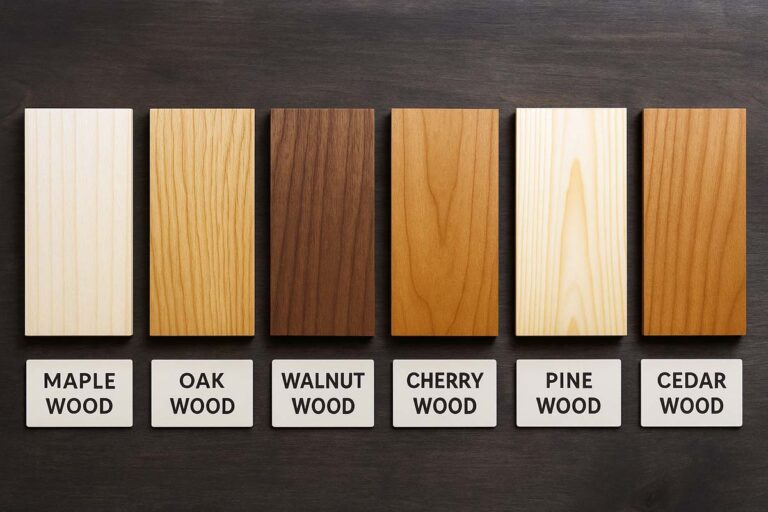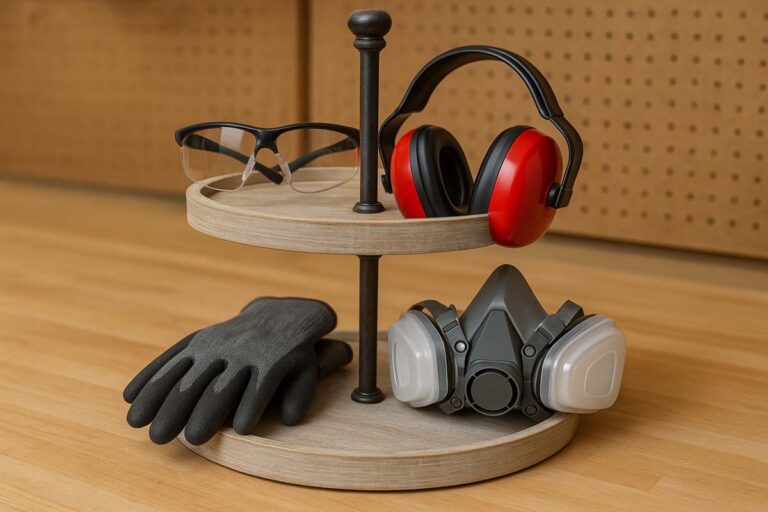How to Choose Between Pine, Oak & Maple
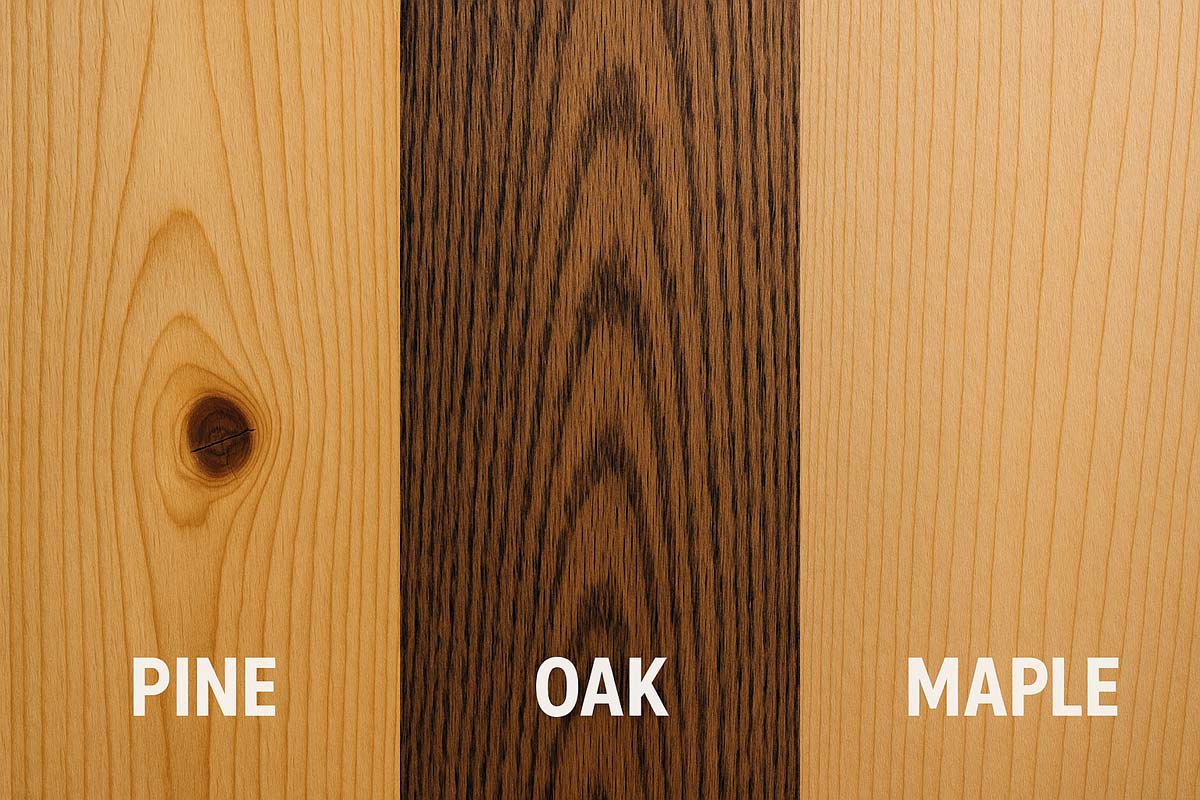
When it comes to crafting a tiered tray stand, one of the most crucial decisions you’ll make is selecting the right wood. Not only does the choice of wood affect the overall aesthetic of your design, but it also impacts the durability, ease of work, and finish of your project. Pine, oak, and maple are three of the most popular wood options for woodworking projects, but how do you choose between them?
Let’s break it down step-by-step, focusing on the features, pros, cons, and use cases for each, so you can make an informed choice that’s best for your tiered tray stand.
Contents Here
- 1 1. Understanding the Basics: Pine, Oak & Maple
- 2 2. Pine Wood: Lightweight & Affordable
- 3 3. Oak Wood: Strong & Classic
- 4 4. Maple Wood: Smooth & Sleek
- 5 5. Comparing the Three: Pine, Oak, and Maple at a Glance
- 6 6. Making Your Choice: Which Wood Is Right for You?
- 7 FAQs about Best Wood for Tiered Tray Stand
- 8 Conclusion: Your Perfect Tiered Tray Stand
1. Understanding the Basics: Pine, Oak & Maple
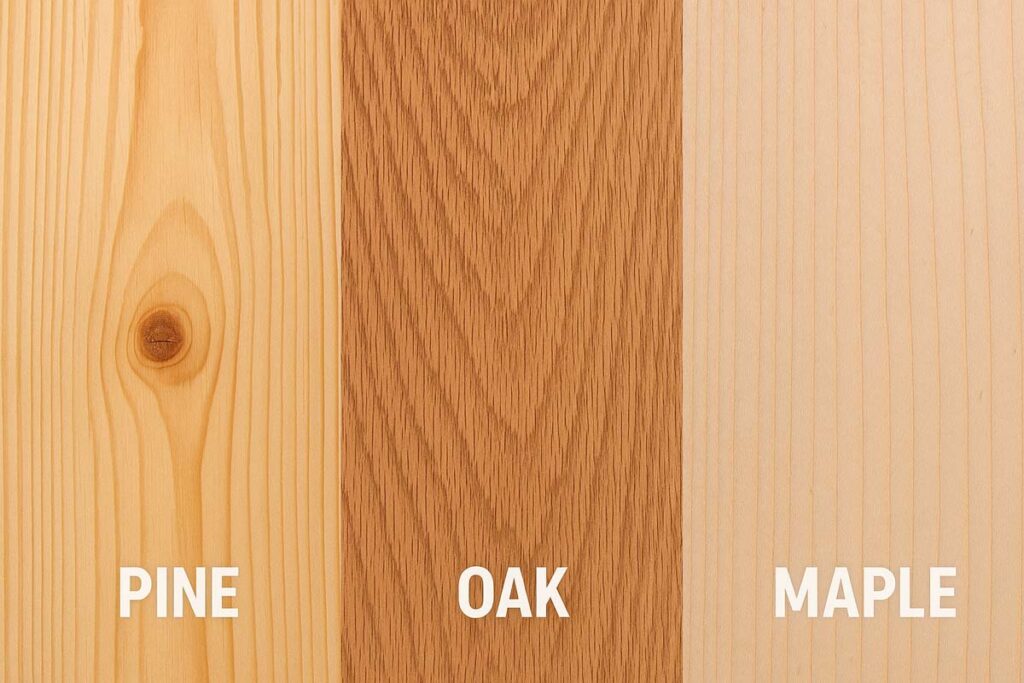
Before diving into the specific qualities of each wood, it’s important to understand the basics. Here’s a brief overview of these three popular types of hardwoods (and softwoods):
- Pine: A softwood that’s commonly available, affordable, and easy to work with.
- Oak: A hardwood known for its strength and distinctive grain patterns.
- Maple: Another hardwood that’s durable and has a fine, consistent texture.
Each wood has its own unique qualities that will impact the look and feel of your tiered tray stand. Let’s explore what makes each wood special and what factors to consider when choosing between them.
2. Pine Wood: Lightweight & Affordable
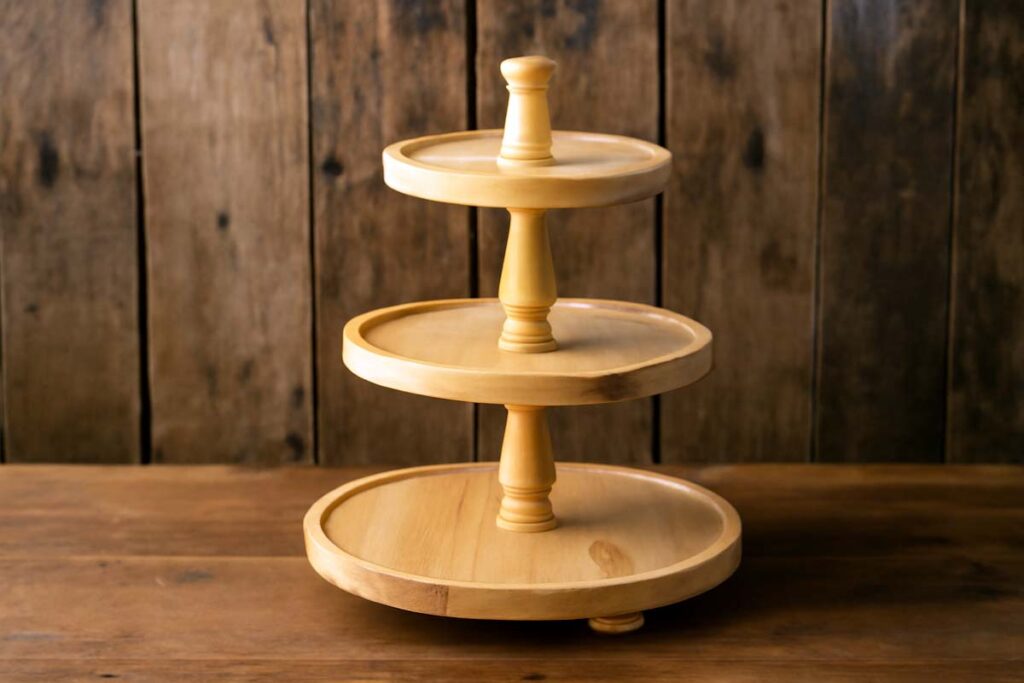
Pine is a softwood, which means it’s lighter than oak and maple. It’s typically more affordable, which makes it a great choice for beginners or those on a budget. Here’s what you should know about working with pine:
Pros:
- Affordable: Pine is one of the cheapest options available, which is perfect if you want to make a budget-friendly tiered tray stand.
- Easy to Work With: Since it’s softwood, pine is relatively easy to cut, shape, and sand. If you’re new to woodworking or need a quicker project, pine is a good choice.
- Lightweight: The lightweight nature of pine means your tray stand will be easy to move around.
- Finishes Well: While it’s a softwood, pine holds paint and stain well, giving you flexibility in the finish.
Cons:
- Less Durable: Being a softwood, pine is more prone to dents and scratches compared to oak or maple. If your tiered tray stand will see heavy use, you might want to reconsider.
- Can Show Knots: Pine often has visible knots, which can either add character or be seen as a flaw, depending on your preference.
- Softer Wood: The softness can cause some challenges if you’re looking for a super sleek, smooth surface or a more polished look.
Best Use Case for Pine:
If you’re building a tiered tray stand that you plan to use for seasonal or occasional décor, pine can be a great option. It’s perfect for those who love the rustic farmhouse aesthetic, or anyone on a budget who still wants to create something beautiful.
3. Oak Wood: Strong & Classic
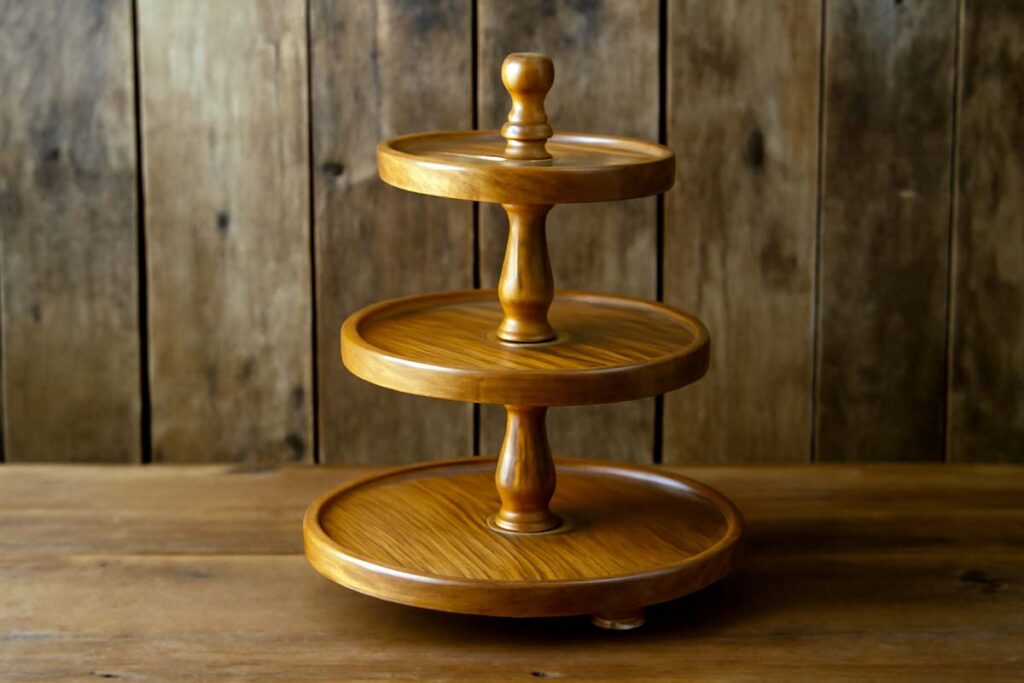
Oak is a hardwood that has been a go-to choice for centuries. It’s tough, durable, and resistant to wear, which makes it ideal for furniture and decor pieces like tiered tray stands. Here’s why oak might be the right choice for you:
Pros:
- Durability: Oak is incredibly durable and resistant to scratches, dents, and wear. If your tray stand will be used regularly, oak can withstand the test of time.
- Distinctive Grain: Oak features a prominent, appealing grain pattern that gives your project a classic look. It’s often used in more traditional or rustic designs.
- Stains & Finishes Well: Oak takes stain and finishes very well, allowing you to achieve a rich, beautiful look. Whether you want to go for a dark finish or a lighter, natural look, oak can handle it.
- Strength: Oak is one of the strongest woods available, making it a good choice for heavier, larger tiered tray stands.
Cons:
- Heavier: Oak is significantly heavier than pine, which could make your tiered tray stand less mobile or difficult to move around if needed.
- More Expensive: Oak is generally pricier than pine, so it might not fit into your budget if you’re looking for a cost-effective project.
- Harder to Work With: The density of oak means it’s a bit more challenging to cut, shape, and sand. You’ll need sharp tools, and sanding may take a little longer.
Best Use Case for Oak:
Oak is perfect for a tiered tray stand that will be used often or needs to support heavier items. It’s also a great choice if you want a high-end, timeless look and are willing to invest in a sturdier, more durable wood. Its rich grain and refined look make it ideal for more traditional, rustic, or even modern farmhouse-inspired designs.
4. Maple Wood: Smooth & Sleek
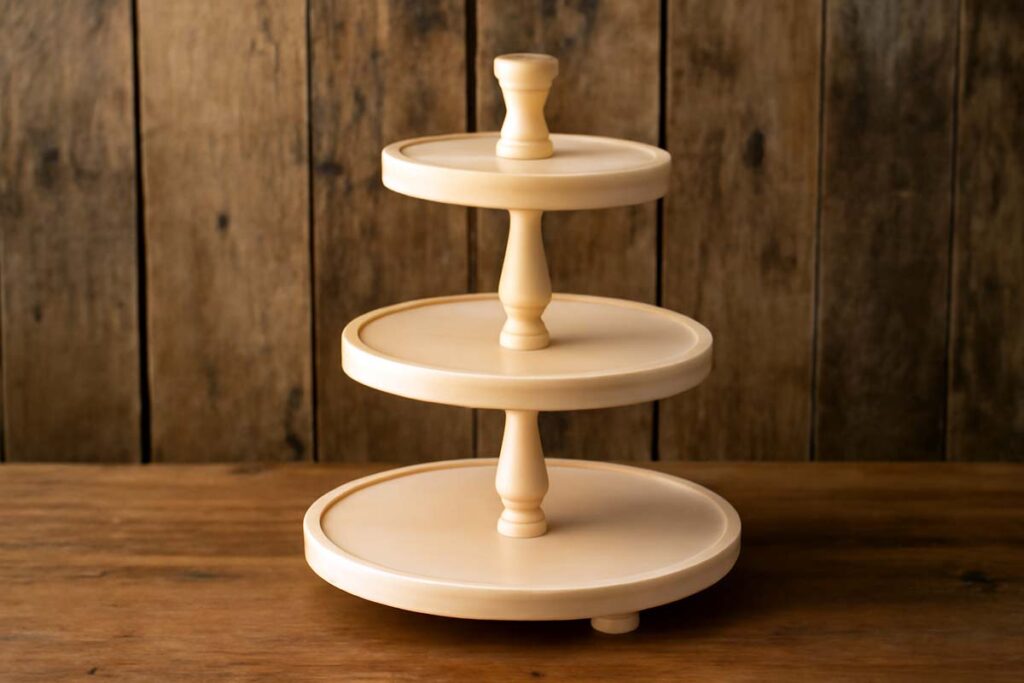
Maple is another hardwood, known for its smooth texture and consistent grain. It’s a versatile wood that’s strong yet visually subtle. Here’s a closer look at why you might choose maple:
Pros:
- Smooth, Consistent Grain: Maple has a tight, consistent grain that makes it ideal for a sleek and modern-looking tiered tray stand. If you prefer a clean, uniform finish, maple is an excellent choice.
- Durability: Like oak, maple is incredibly strong and resistant to wear. It’s a great option for projects that need to withstand regular use.
- Finishes Well: Maple holds paint and stain very well. Whether you want to leave it natural or add some color, maple can handle it.
- Hard, Resilient Wood: Maple’s hardness makes it ideal for a tiered tray stand that will take a beating. It resists scratching and denting much better than pine.
Cons:
- Hard to Work With: Due to its density, maple can be a bit harder to cut, shape, and sand. Like oak, you’ll need sharp tools and patience.
- Can Be Expensive: Maple can also be on the pricier side, especially for high-quality pieces. However, it’s not as expensive as oak in most cases.
- More Difficult to Stain: Maple can sometimes be tricky to stain evenly, so it may require extra care or a special pre-stain treatment to get the finish you want.
Best Use Case for Maple:
Maple is the ideal choice if you’re looking for a smooth, sleek, and modern design for your tiered tray stand. It’s also a great option if you’re going for a lighter-colored wood or want a finish that will be sleek and refined. Its durability makes it a good choice for a stand that will see regular use or heavy items.
5. Comparing the Three: Pine, Oak, and Maple at a Glance
Here’s a quick comparison table to help summarize the key differences between these three woods:
| Feature | Pine | Oak | Maple |
|---|---|---|---|
| Wood Type | Softwood | Hardwood | Hardwood |
| Cost | Low | Moderate to High | Moderate to High |
| Durability | Low to Moderate | High | High |
| Workability | Easy to work with | Challenging | Challenging |
| Grain Pattern | Subtle, rustic | Bold & prominent | Fine & consistent |
| Weight | Light | Heavy | Moderate |
| Best for | Budget projects, rustic look | Traditional, durable stands | Sleek, modern, and refined designs |
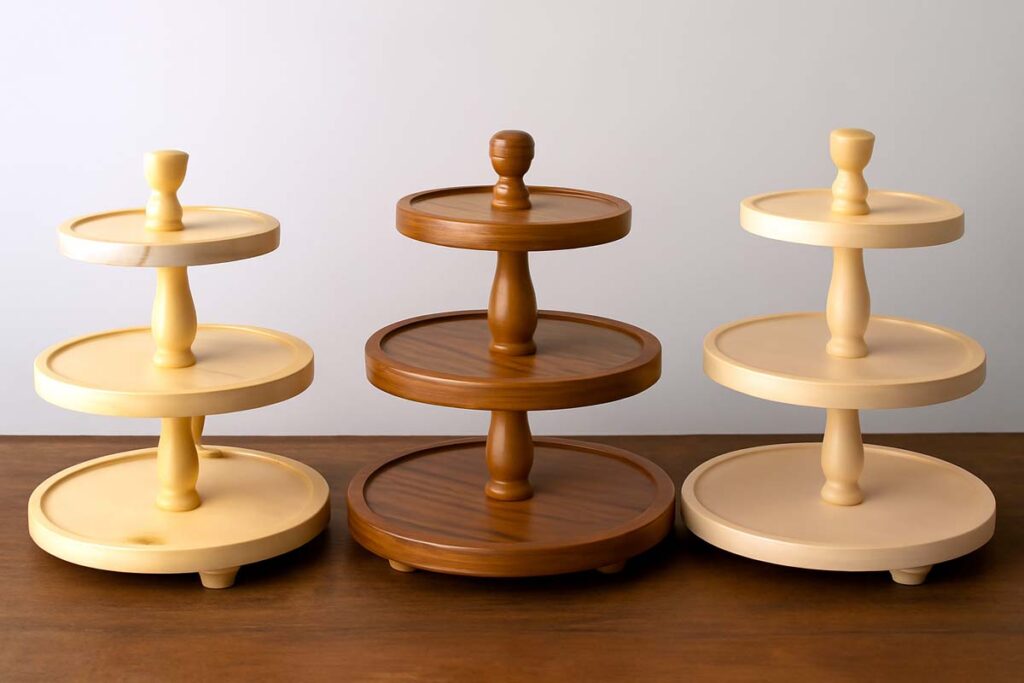
6. Making Your Choice: Which Wood Is Right for You?
Now that you know the pros and cons of pine, oak, and maple, it’s time to make your decision. Consider the following questions when choosing the right wood for your tiered tray stand:
- What’s Your Budget? If you’re working on a tight budget, pine is your best bet. It’s affordable, easy to work with, and can still give you a great-looking tray stand.
- How Durable Does It Need to Be? If you want a stand that will last for years and stand up to regular use, oak or maple are better choices. Both are sturdy hardwoods that resist wear and tear.
- What’s Your Style? Do you prefer a rustic, farmhouse look (pine)? Or are you after a more classic, traditional feel (oak)? If you want something sleek and modern, maple could be your best option.
- How Comfortable Are You with Woodworking? Pine is the easiest to work with, so if you’re a beginner, it’s the most forgiving. Oak and maple require more skill and the right tools.
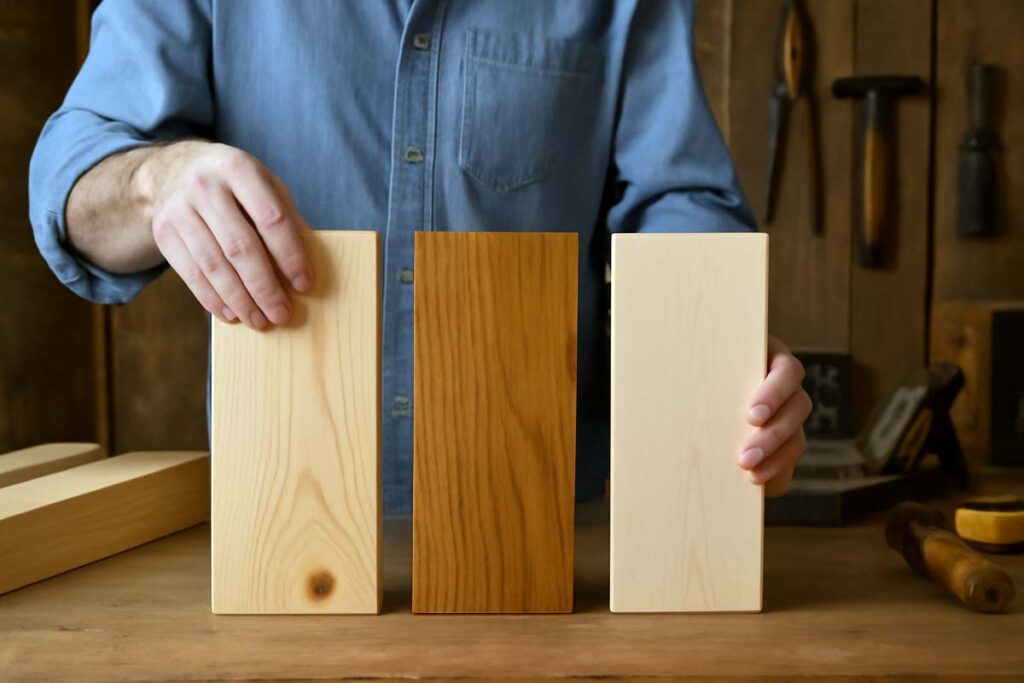
FAQs about Best Wood for Tiered Tray Stand
Conclusion: Your Perfect Tiered Tray Stand
Choosing the right wood for your tiered tray stand comes down to your personal preferences, budget, and the specific look you want to achieve. Whether you go with pine for its affordability and rustic charm, oak for its strength and classic appeal, or maple for its smooth finish and modern look, each wood has its own unique benefits that can help bring your vision to life.
As a woodworker, I always recommend taking the time to feel the wood before you start your project. See how it handles, how it feels, and how it fits with the overall design you’re envisioning. With the right wood in hand, your tiered tray stand will not only be beautiful but also durable enough to last for years to come. Happy woodworking!

